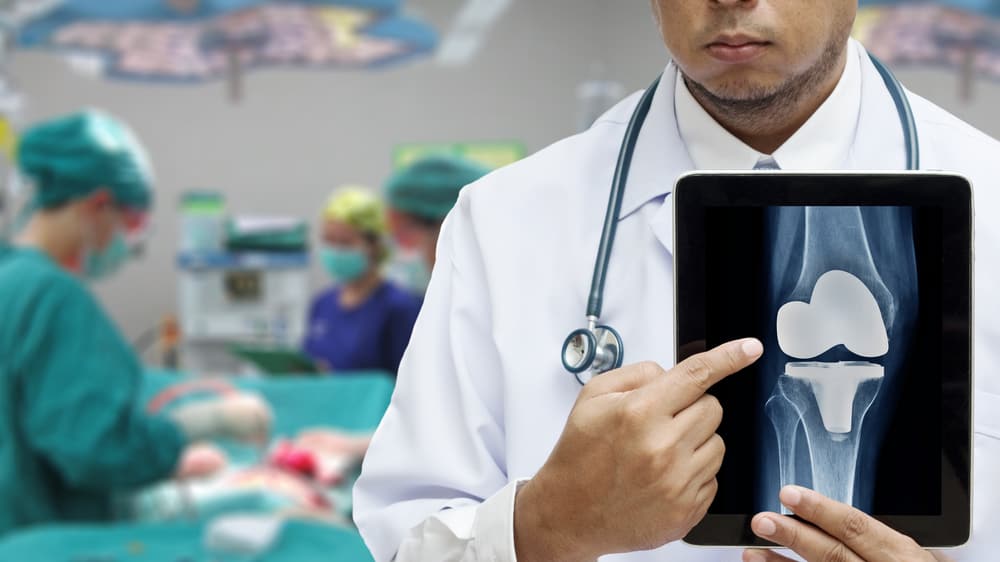
Dec 12, 2020
Following injury to the articular surface of the knee, measurable changes in the joint microenvironment can occur, including altered expression of proinflammatory cytokines, matrix metalloproteinases (MMPs), aggrecanases, growth factors, and apoptotic factors. A study assessing the impact of 10 synovial fluid biomarkers at the time of knee injury found that three specific biomarkers can predict with moderate accuracy functional outcomes and level of pain postoperative at five years.
The development of post-traumatic osteoarthritis (PTOA) affects a large percentage of patients with anterior cruciate ligament (ACL) tears, meniscus tears, and other knee injuries. Even when an injury is surgically treated, the joint is at a significantly increased risk of PTOA five to 10 or more years following the initial insult. It is believed that the accelerated cartilage degradation associated with PTOA is the result of inflammatory chemokines released into the joint space at the time of injury. In other words, the initial seed of post-traumatic osteoarthritis is planted at the time of the injury, and there may be a specific pattern of molecular biomarkers in the synovial fluid (i.e., an inflammatory phenotype) that is able to predict which patients are at the highest risk of diminished function and development of OA as a result of their knee trauma.
Cellular Therapy to Prevent Osteoarthritis After Knee Surgery
The study prospectively enrolled 39 patients (mean age at time of surgery, 41.56 years) undergoing primary knee arthroscopy for ACL injury, meniscus injury, and/or focal chondral lesion beginning in October 2011. Patients were excluded if they had any additional associated ligament injury, systemic inflammatory disease, autoimmune disease, intra-articular corticosteroid injection in the three months before surgery, prior knee surgery, immunomodulatory drug use, chemotherapy within the past year, insufficient synovial fluid aspiration, or cartilage/meniscal transplantation in addition to arthroscopy. Those aged 18 years or younger also were excluded.
Immediately prior to surgical incision, synovial fluid was aspirated from the operative knee and transferred to sterile tubes containing a protease inhibitor cocktail solution. Researchers assessed the concentration of 10 cytokines and chemokines that have previously been suggested to play a role in cartilage degradation and inflammation in the joint space.
Among 28 patients who did not undergo further surgery since the time of synovial fluid sampling, the biomarkers MMP-3 (a proinflammatory enzyme), TIMP-2 (an anti-inflammatory inhibitor of MMPs), and vascular endothelial growth factor (an angiogenesis-inducing growth factor) most accurately predicted functional outcomes at five years postoperative or injury. These findings support my recommendations for use of Bone Marrow Concentrate, Proprietary Platelet Rich Plasma, Stem Cells or Growth Factors following knee injury or arthroscopic knee surgery to postpone, perhaps avoid a Total Joint Replacement
To learn more, visit my web site and watch my webinar at www.sheinkopmd.com
For a consultation call (312) 475-1893
Tags: Cellular Therapy for knee pain, joint pain, knee health, knee pain, knee surgery

Aug 20, 2020
Better stated, how do you bridge the gaps in the continuum of joint care from early intervention to joint replacement?
Arthritic Joint Pain Management
First and foremost, our goal is functional restoration and maintenance, relieving symptoms, and postponing, perhaps avoiding joint replacement. In the beginning, conservative measures might include non-steroidal anti-inflammatory medications, weight reduction, physical therapy for strengthening muscles and preserving or restoring a full range of joint motion. At times, an unloader brace may be of benefit in settings where a joint shows early signs of mechanical changes such as a knock knee (valgus) or bowed leg (varus). In addition to the aforementioned measures, joint preservation is a major goal using such measures as Platelet Rich Plasma, Highly Cross-linked Hyaluronic Acid and Acellular Amniotic Fluid.
Within the Preservation Classification, there are multiple options available. Our evidence-based practice concentrates on those options in which we have done outcome research; as well as published our results in scientific journals. Only using evidence-based options allows us to provide the patient the highest chance of a successful outcome.
Cellular Therapy to Treat Joints
There are times in the continuum of care that the patient will present further along in the arthritic process so that Conserve and Preserve are no longer indicated. Joint Restoration is the next consideration that might or could go a long way in postponing or even avoiding a joint replacement. Autologous Growth Factor Solutions contain proteins circulating in your blood that potentially stops pain, and reverses the arthritic process at the molecular level in the joint. The ultimate Regenerative Orthopedic approach is stem cell mediated and bone marrow concentrate is the only FDA approved source of mesenchymal stem cells at this time. Your bone marrow is recovered by an outpatient aspiration procedure, the recovered bone marrow via a specially designed needle, (troachar), contains adult mesenchymal stem cells, exosomes, platelets, growth factors and precursor cells. When concentrated, your bone marrow is the richest source of joint restoration potential available to date. It is FDA approved as long as guidelines are adhered to; has no potential for disease transfer; and offers pain relief, return of motion and function, and postponement, perhaps avoidance of a joint replacement. Please note that I indicated “at this time.”
The Personalized Stem Cell trial in which I played a major role just concluded. The results are being analyzed. In the PSC Trial, the source of stem cells was adipose tissue, abdominal fat. When approved, Personalized Stem Cells will allow abdominal fat to serve as an alternative source of stem cells in addition to bone marrow on a clinical basis. The next advance will come following the FDA approval for the PSC trial of stem cell culturing. To stay informed, read my weekly blog. To schedule a consultation call (847)390-7666. You may visit my web site and attend a webinar at www.sheinkopmd.com
Tags: arthritic joint pain, arthritis, cellular therapy for arthritic joints, joint, joint pain, preventing joint replacements

May 29, 2020
There are statistics and anecdotes that are used to review the outcomes of a particular cellular orthopedic treatment option and help determine what is best for a patient with arthritis. At times, it is difficult, and even impossible, to develop a sufficient number of patients with similar problems that might enable a statistical analysis. At that time, we have to base our recommendations on anecdotes; that is small numbers of patient responses. Two and a half years ago, a 67-year-old cycling enthusiast presented to our office with progressive pain and loss of motion owing to osteoarthritis of both knees. By the time he presented, the customary approaches to the arthritic knee had been exhausted including Physical Therapy, analgesics, non-steroidal anti-inflammatory medications, Hyaluronic Acid injections and arthroscopic “clean out.” Total Knee Replacements had been prescribed as the treatment option when all else had failed.
Patient Outcome Anecdotes
The patient had learned of my Cellular Orthopedic initiatives from his cycling group and sought consultation in our offices. The “team” of senior cyclists had experienced the recent loss of two team members because of their having experienced less than optimal outcomes following Total Knee Replacements. After our office assessment and review of images, I recommended a Bone Marrow Concentrate injection in both knees to help post postpone, perhaps avoid major surgery in the avid cyclist. I chose Bone Marrow Concentrate as the optimal means of delivering Adult Mesenchymal Stem Cells, Platelets, Precursor Cells and Growth Factor Proteins. The procedures were done on November 22nd of 2017. At this yearly follow up assessment, the patient reported that he has no pain, no limitation of function, requires no medications for arthritis and enjoys an unlimited weekly cycling routine approaching 300 miles per week.
A second example, or anecdote, is this senior athletic enthusiast, me. Many who know me are aware of my arthritic knees and hips for which I have had two rounds of biologic interventions in the past four years. Over the Memorial Day weekend, I cycled a combined 70 miles in Southwest Wisconsin, on hilly terrain, at times accompanied by my wife and twin grandsons; finished planting a large garden by hand; and helped clean our farmhouse, as we hosted and entertained our three grandchildren( ages 12, 10 and 10) with parents -the latter the most strenuous task of all.
While there is a medical cliché, “an anecdote does not a series make”, the vignettes above are real examples of what may be done for a symptomatic and functionally limiting arthritic joint. To learn more about orthobiologic options from proprietary Platelet Rich Plasma to stem cells and then some, call and schedule an appointment at (312) 475-1893. You may visit my website at www.sheinkopmd.com and watch my webinar.
Tags: arthritis pain, joint pain, patient outcomes, stem cell therapy, stem cell treatments
May 15, 2019
The New York Times: 2019/05/13 “Stem cell Treatments Flourish with Little Evidence That They Work”
Several years ago, I asked a question of a cellular biologist as to how is Bone Marrow Concentrate effective if the number of adult mesenchymal stem cells diminish as we age? His response: “Bone Marrow contains lots of things including stem cells and proteins called cytokines or growth factors. It may be that the growth factors are most important in joint restoration and blocking pain.”
Let’s take for example, inflammatory arthritis such as Rheumatoid and Psoriatic arthritis. The common denominator is a pro-inflammatory cytokine called Tissue Necrosis Factor found in the body’s immune system. The growth factor, TNF-alpha blocker is now used to control the inflammation and alter the body’s immune response to the proinflammatory protein. As a result of TNF-alpha blockers, Phil Mickelson is a very competitive golf professional, (You have seen him as a spokes person for Psoriatic Arthritis treatment with Humira). Since the introduction of TNF alpha blockers in Scandinavia five years ago, there has been a 40% reduction in Total Knee Replacements for inflammatory arthritis. When Kobe Bryant traveled to Dusseldorf, Germany almost nine years ago, he received treatment for a very arthritic knee with Interleukin -1 Receptor Antagonist Protein, along with other blockers. Shortly thereafter, he returned to play another five years in the NBA. The IRAP that Bryant received was and is an anti-inflammatory, a growth factor blocker, a cytokine.
As I agree in part with the criticism in the New York Times concerning Stem Cells, those who read this Blog will recall that I don’t “sell” stem cells. Bone Marrow is used in part because of the fact that it contains stem cells; but more importantly as we age, Bone Marrow contains Growth Factors, the anti-inflammatory protein Cytokines that restore a joint by minimizing pain and improving function. Over the last eight years, we have accumulated the evidence that Bone Marrow Concentrate works for arthritis via stem cells, growth factors, or all of the above. Recently we have taken a major step forward by filtering high concentrations of Growth Factors from the Platelet Poor Plasma, previously discarded, that remained after we centrifuge the bone marrow and add the filtrate to that which is injected into the painful joint. Stem Cells maybe, highly concentrated Growth Factors that act to block pain and improve function, for certain.
You may learn more by visiting my web site at www.sheinkopmd.com or call for a consultation (847)390-7666
Tags: ACL, ACL Injury, anterior cruciate, arthritic knee, arthritis, Autologous Protein Concentrate, BMC, board-certified, Bone Marrow Concentrate, bone marrow edema, cells, cellular orthopedic, cellular orthopedics, FDA, Growth Factors, hematopoietic cell, inflammatory arthritis, injection, Interleukin 1 Receptor Antagonist Protein, IRAP, joint health, joint pain, knee replacement, Kobe Bryant, meniscal injury, meniscectomy, Mesenchymal Stem Cell, micro-fragmented adipose, muscle injury, muscle strain, nterleukin -1 Receptor Antagonist Protein, OA, Orthopedic Surgeon, Osteoarthritis, pain, Physical Therapy, Platelet Rich Plasma, platelets, pro-inflammatory cytokine, PRP, Psoriatic Arthritis, regenerative medicine, repair, Rotator cuff tear, sports injuries, sports medicine, stem cells, strain, tear, Tissue Necrosis Factor, TNF alpha blocker, torn medial meniscus, training
Apr 11, 2019
I consider myself an aging athlete who still skis, cycles, dedicates five days a week to fitness, plans to soon plant a garden, and walks up a spring creek with a fly rod. When my arthritic hips and knees began to limit my recreational profile several years ago, I chose the regenerative medicine option rather than joint replacements. Having performed joint replacements for 37 years and studied the benefits and limitations of such, I elected to postpone, perhaps avoid major surgery with the inherent risks and limitations. First it was Platelet rich plasma, next came PRP with Growth factor Proteins; and next came stem cells. At the get go, I did not expect to regenerate cartilage; but I did hope to restore joint function, minimize pain, and maintain the highest possible activity potential. Even with Grade 4 osteoarthritis of my major joints, I can report that I skied for a week in Vail this past February as I did a year ago, recently spent three days wading though spring creeks in Southwestern Wisconsin with a fly rod in pursuit of trout, and cycled 30 miles last Saturday. I am not alone as my biking, skiing and cycling buddy with similar knee issues returned last week from his yearly helicopter skiing adventure. I have been managing his knee arthritic issues with regenerative medicine interventions for over five years.
Then there are the athletes in their 50s. Certainly, the option is there for a joint replacement for a grade three arthritic joint but what If? What if there is a complication, an adverse event, a failure to regain motion, or residual pain? The fall back potion after a failed joint replacement is another joint replacement and the outcomes of revision surgery are frequently not satisfactory. Several weeks ago, I described the recreational pursuits of a 58-year-old volleyball enthusiast who had initially considered a joint replacement when 15 years after an arthroscopic partial meniscectomy, the predictable post traumatic arthritis had forced him to suspend his activities. He chose a regenerative medicine stem cell option; and eight weeks thereafter, he is back to playing volleyball three times a week. While on occasion, a booster follow-up injection is needed; we are in the process of developing a manuscript for scientific publication focusing on the successful outcomes of 20 patients followed for one to two years after a combined injection of bone marrow concentrate containing stem cells into the knee and the bone adjacent to the knee. These are recreational athletes between ages 45 and 60 who won’t quit.
On May 4, I am one of three invited faculty to present at The Regenerative Medicine Training Institute (RMTI). On June 7 and 8, I have been asked to participate in the Workshop and Lab Faculty at the largest Regenerative Medicine program in North America (TOBI). Owing to our integration of patient care with scientific outcomes monitoring, we have been able and continue to provide masterful and evidence-based care to aging athletes. To continue to remain in the forefront of Regenerative Medicine, I dedicate a good deal of time reviewing the future while monitoring the outcomes of patient care. Several new treatment options are soon to be launched including expanding my scope of care to those with inflammatory arthritis.
To learn more, call for a consultation (312) 475-1893. You may visit my website: www.sheinkopmd.com
Tags: ACL, ACL Injury, anterior cruciate, arthritic knee, arthritis, Autologous Protein Concentrate, baseball, BMC, board-certified, Bone Marrow Concentrate, bone marrow edema, cells, cellular orthopedic, cellular orthopedics, FDA, football, golf, Growth Factors, hematopoietic cell, injection, Interleukin 1 Receptor Antagonist Protein, IRAP, joint health, joint pain, knee replacement, lipogems, meniscal injury, meniscectomy, Mesenchymal Stem Cell, micro-fragmented adipose, muscle injury, muscle strain, OA, Orthopedic Surgeon, Osteoarthritis, pain, Physical Therapy, Platelet Rich Plasma, platelets, PRP, regenerative medicine, repair, Rotator cuff tear, soccer, sports injuries, sports medicine, stem cells, strain, tear, torn medial meniscus, training, volleyball


